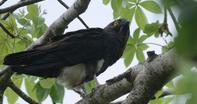
Name
Bat Hawk (Macheiramphus alcinus)Appearance
The adult bat hawk is brownish black all over, except for a white spot above and below the eye. The centre of the chest and throat are white, with a broad black median streak.
The eyes are brilliant yellow and the cere black. The legs and feet are a pale bluish-grey. The immature bat hawk is a more mottled brown with a paler colour on the basis of the tail feathers, and more white on the breast.
Bat Hawk Diet
Bats are the usual prey of the bat hawk, although they may occasionally eat small birds like swallows, swifts, and swiftlets or even insects.
They hunt by chasing their prey at high speeds in flight. It never descends to the ground for prey, but will relentlessly pursue its victim, even into buildings.
Bat Hawk Breeding
Courtship involves a great deal of aerial chasing near the breeding site. The stunt flying like a lapwing and sometimes foot-touching and rolling displays at high speeds is spectacular. When approaching the nest tree the bat hawk come in very fast but low and then suddenly sweep up on to a perch.
Both sexes build the nest with the female doing most of the work. This nest is often in the same tree the birds spend most of their time in perching during the day. The bat hawk nest is usually high up in a tree and twigs are broken off dead branches in flight and dropped onto the nest site. It is built on a large lateral limb, but sometimes in the middle of the tree.
This fair-sized structure, about three feet across by one foot deep, are sometimes unlined, unlike other birds of prey. Both in the East and in Africa it sometimes nests in busy towns. Normally each year just a single egg is laid.
The female is solely responsible for incubating the egg, and she only takes an occasional flight at dusk. The male does most of the hunting and shares food with her on the nest or near it.
The incubation period is estimated at about a month. The young fledge in about 35-40 days and are fed just before dark by both parents. During this time the feeding rate is rapid, once every three or four minutes and the parents deposit the food on the nest edge and fly off, returning shortly with more.
The prey brought to the young often includes insects. During the early part of the fledging period the female remains on the nest with the young, but in the last week or ten days of the period, the parents both sit on branches of the nest tree or adjacent trees. The young only remain in the vicinity of the nest for a short time after fledging.
Bat Hawk Behaviour
The bat hawk is mostly silent, but at dusk and in display it makes varied high-pitched, broken whistles, ‘ki-kik-kik-kik-keee’ or ‘kwiek-kwiek’. These calls sound weak for the size of the bird.
The bat hawk looks like a dark, long-winged, slender bird about the size of a small buzzard, but with the flight silhouette of a large falcon. The white throat with a median streak and large bright yellow eye are good pointers.
The most important thing for the bat hawk is open space with loads of bats, swallows or other food which can be preyed on in flight. It can be seen in the evening hunting over pools, large rivers, and creeks, beaches, railway platforms, or even large lawns near buildings.
When hunting the bat hawk either quarters or circles over its chosen area, usually at great speed, looking above, below, and on both sides of it (unlike most birds of prey, which look downwards).
To enable it to catch enough to survive in the short time available the prey must be plentiful and small, and it does not eat large fruit bats. The prey is caught in the feet and swallowed whole while flying.
During the day the bat hawk sits motionless in a large tree, rarely, if ever, leaving it even for a short flight, though it may sometimes be seen flying about in daylight, especially in the breeding season. Very early in the morning or a little before dusk, it takes wing, and hunts until the light has all but gone.
The bat hawk only hunts for about half an hour each day in Africa, but longer in the East, where the prey is swiftlets rather than bats. In the Far East, it frequents the mouths of limestone and other caves inhabited by birds-nest swiftlets. It is a rare bird through most of its range, but is quite common where it is found, and frequents towns as well as the countryside.
 SouthAfrica.co.za provides informative, educational content on many South African bird species that orthologists and bird-watchers would enj...
SouthAfrica.co.za provides informative, educational content on many South African bird species that orthologists and bird-watchers would enj...